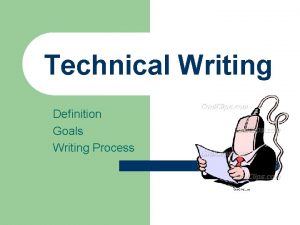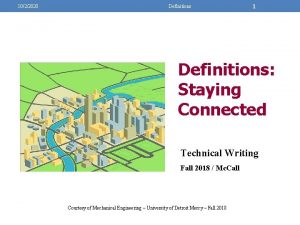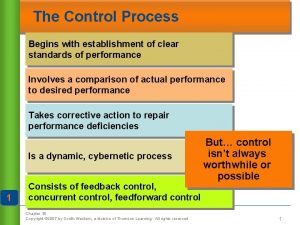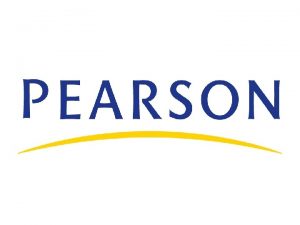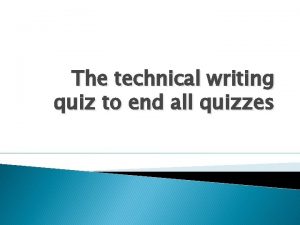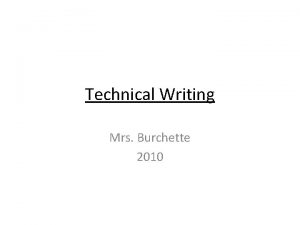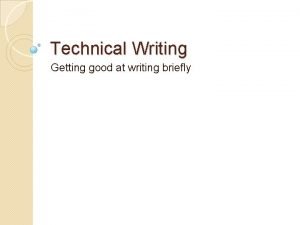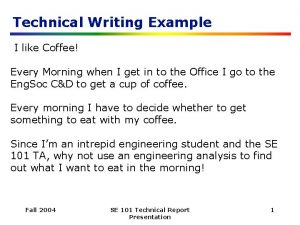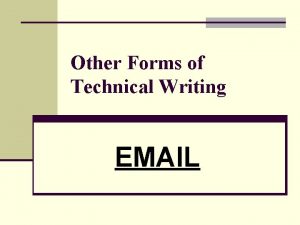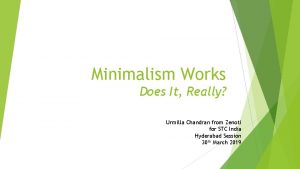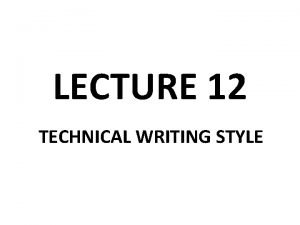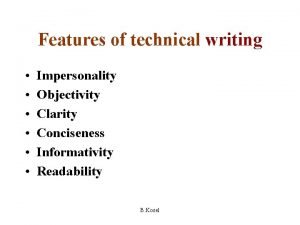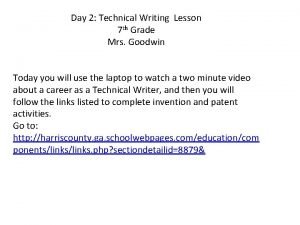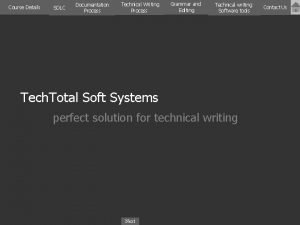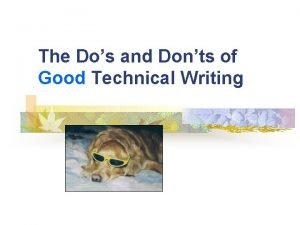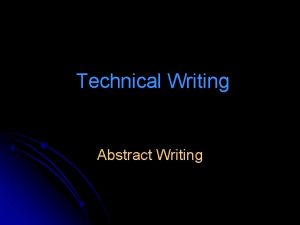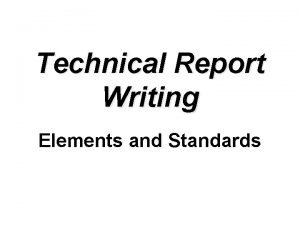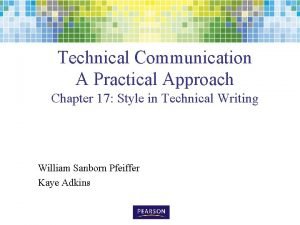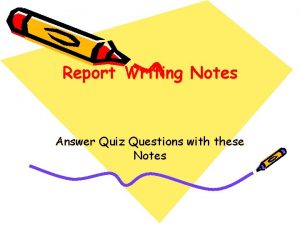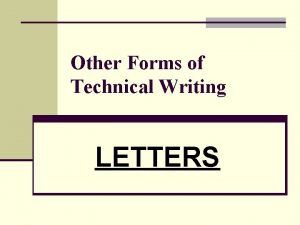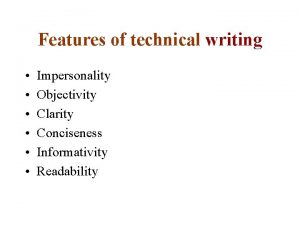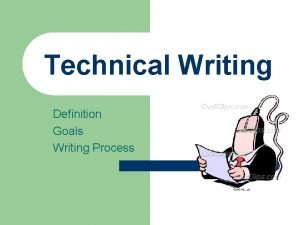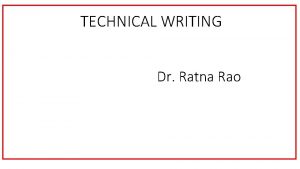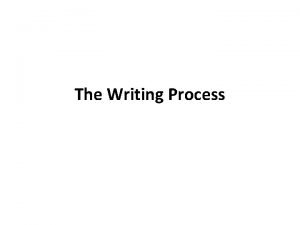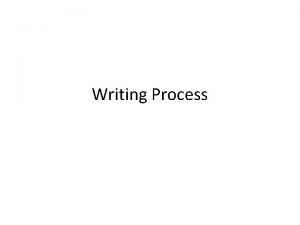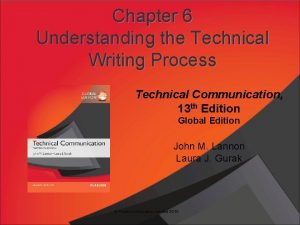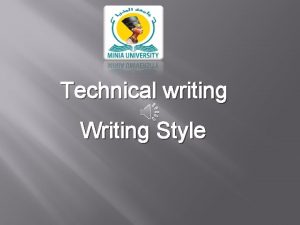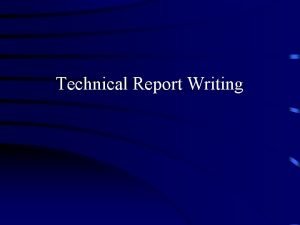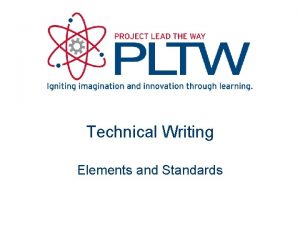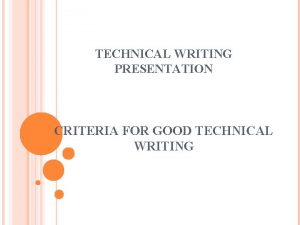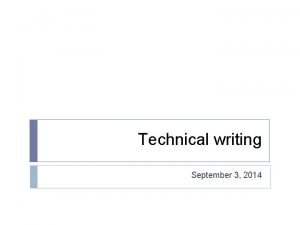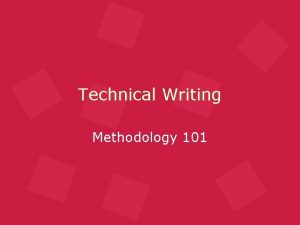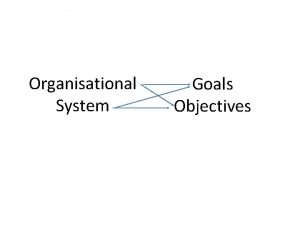Technical Writing Definition Goals Writing Process What is






























- Slides: 30

Technical Writing Definition Goals Writing Process

What is Technical Writing? l Technical writing……. . ? l Introduces you to some of the most important aspects of writing in the world of science, technology, and business l The kind of writing that scientists, nurses, doctors, computer specialists, government officials, engineers, and other people do as a part of their regular work.

What is Technical Writing? l Term “technical” refers to l Knowledge that is not widespread, that expand the territory of experts & specialists. l Whatever is your major subject / area / interest, you are developing an expertise……! l Whenever you try to write anything about your field, you are engaged in technical writing.

What is Technical Writing? l Technical communication… written, oral, visual l Composed in and for the workplace. l A significant factor in work experience for a variety of reasons. l Serves valuable purposes in the workplace and often involves teamwork.

Importance of Teamwork l Business & industry …. Expectations … results of teamwork. l Business management philosophies depend upon teamwork. l Total Quality Management (TQM) and continuous improvement programs encourage efficient teamwork. l Strategies for successful collaboration can improve outcomes.

What is the purpose of technical writing? l Delivery of technical information to readers in a manner that is adapted to their needs, level of understanding, and background. l Intended to communicate to a specific audience, for a specific purpose.

The Audience l Audience element is so important that it is one of the cornerstones of technical writing. l You are challenged to write about highly technical subjects but in a way that a beginner—a non-specialist—could understand.

Translating Technical Information l World of rapid technological development…. . people are constantly falling behind and becoming technological illiterates. l As a technical writer, plan to write about in such a way that even Grand dad can understand.

Goals of Effective Technical Writing l Clarity l Conciseness l Accuracy l Organization l Ethics

Effective Technical Writing: Clarity Methods for developing ideas precisely v An expressive essay can clarify the writer’s intent through emotional, impressionistic, connotative words (soon, many, several, etc. ). v An impressionistic word such as “near” will mean different things to different people which is okay in an essay where the goal may be to convey a feeling.

Effective Technical Writing: Clarity l Ultimate goal …. is to say the same thing to every reader. l Let’s say I write instructional manuals for company manufacturing space heaters. l If I write, “Place the space heater near an open window, ” what will this mean to thousands of customers who purchase the machine?

Effective Technical Writing: Clarity l One person may place the heater 6 feet from the window. l Another reader will place the heater 6 inches from the window. l As the writer, I have failed to communicate clearly.

Effective Technical Writing: Clarity l Specify – Provide specific detail – Avoid vague words (some, recently) – Answer reporters’ questions (who, what, where, when, why, how)

Effective Technical Writing: Clarity l Avoid obscure words – – Use easily understood words Write to express, not to impress Write to communicate, not to confuse Write the way you speak aforementioned in lieu of already discussed instead of

Effective Technical Writing: Clarity l Limit and/or define your use of abbreviations , acronyms, and jargon. Ø Define your terms parenthetically Ø CIA (Cash in Advance) or Ø Supply a separate glossary Ø Alphabetized definitions list of terms, followed by their

Effective Technical Writing: Clarity l Use the active versus the passive voice. Ø Passive voice: It was decided all employees will take a ten percent cut in pay. Unclear: Who decided? Ø Active: The Board of Directors decided that all employees. . . Ø Overtime is favored by hourly workers. Wordy Ø Active: Hourly workers favor overtime. Ø

Effective Technical Writing: Conciseness l Limit paragraph, word, and sentence length. – – A paragraph in a memo, letter, or short report should consist of l No more than four to six typed lines or l No more than fifty words. Fog index (sixth to eighth grade level) l Strive for an average of 15 words per sentence l No more than 5 multisyllabic words per 100 words

Effective Technical Writing: Conciseness Fog Index l Count up to 100 words in successive sentences – Divide words by number of sentences = average number of words per sentence l Count number of long words (three or more syllables) within sentences – Don’t count proper names (Christopher Columbus), long words created by combining shorter words (chairperson), or three syllable words created by ed or es endings (united).

Effective Technical Writing: Conciseness – Use the meat cleaver theory of revision l Cut – – the sentence in half or thirds Avoid shun words l Avoid words ending in –tion or –sion l Came to the conclusion concluded Avoid camouflaged words l Make an amendment to amend

Effective Technical Writing: Conciseness l Avoid the expletive pattern – – l There is, are, was, were, will be It is, was There are three people who will work for Acme. Three people will work for Acme. Omit redundancies – – During the year of 1996 During 1996

Effective Technical Writing: Conciseness l Avoid wordy phrases – In order to purchase l Proofread for accuracy l Consider ethics to purchase

Effective Technical Writing: Accuracy l The importance of correct grammar and mechanics – Grammatical or mechanical errors make writers look unprofessional and incompetent.

Effective Technical Writing: Accuracy l Grammar is so important in technical writing that in a one page assignment – – l 4 major grammatical errors = F 3 major grammatical errors = D 2 major grammatical errors = C 1 major grammatical error = B “A” means “excellent” which is defined as “without flaw”

Effective Technical Writing: Organization l Methods for organizing – Spatial – General to Specific – Chronological – Mechanism Description – Process Description – Classification

Effective Technical Writing: Organization l Methods for organizing – Definition – Comparison/Contrast – More Important to Less Important – Situation-Problem-Solution. Evaluation – Cause-Effect

Effective Technical Writing: Ethics l Ethics – methods encouraging moral standards in technical writing – Practical – Legal – Moral

Effective Technical Writing: Ethics l General categories of ethics in communication – Behavior towards colleagues, subordinates and others (plagiarism, harassment, malicious actions) – Dealing with experimental subjects, interviewees, etc. (informed consent) – Telling the “truth” (falsify data, misrepresent facts) – Rhetoric—choosing your words (loaded words, discriminatory language, logical fallacies)

Effective Technical Writing: Process l The writing process is effective. . . and easy. l All that you need to do is three things: – Prewrite (about 25 percent of your time) – Write (about 25 percent of your time) – Rewrite (about 50 percent of your time)

Effective Technical Writing: Prewriting Techniques l Reporter’s questions l Mind mapping l Brainstorming/listing l Flowcharting l Outlining l Storyboarding

Technical Writing l l l Is important to success in business Lets you conduct business Takes time Costs the company Reflects your interpersonal communication skills Often involves teamwork
 Strategic goals tactical goals operational goals
Strategic goals tactical goals operational goals Strategic goals tactical goals operational goals
Strategic goals tactical goals operational goals Technical writing
Technical writing General goals and specific goals
General goals and specific goals Examples of generic goals and product-specific goals
Examples of generic goals and product-specific goals Difference between academic and technical writing
Difference between academic and technical writing Term class distinguishing features
Term class distinguishing features The accounting process begins with
The accounting process begins with Technical communication process and product
Technical communication process and product Functional goals examples
Functional goals examples Technical report writing quiz
Technical report writing quiz Technical writing acrostic
Technical writing acrostic What are the characteristics of technical writing
What are the characteristics of technical writing Technical writing examples
Technical writing examples Abcs of technical writing
Abcs of technical writing Minimalism in technical writing
Minimalism in technical writing What is technical style
What is technical style Features of technical writing
Features of technical writing Technical writing lesson plans
Technical writing lesson plans Technical writer portfolio example
Technical writer portfolio example Sdlc technical writing
Sdlc technical writing Is an abstract in first person
Is an abstract in first person Dos and don'ts of technical writing
Dos and don'ts of technical writing Conciseness & style
Conciseness & style Abstract in technical writing
Abstract in technical writing Elements of technical report writing
Elements of technical report writing Technical writing style
Technical writing style Professional letters
Professional letters Feasibility criteria example
Feasibility criteria example Abc format technical writing
Abc format technical writing Objectivity in technical writing
Objectivity in technical writing


